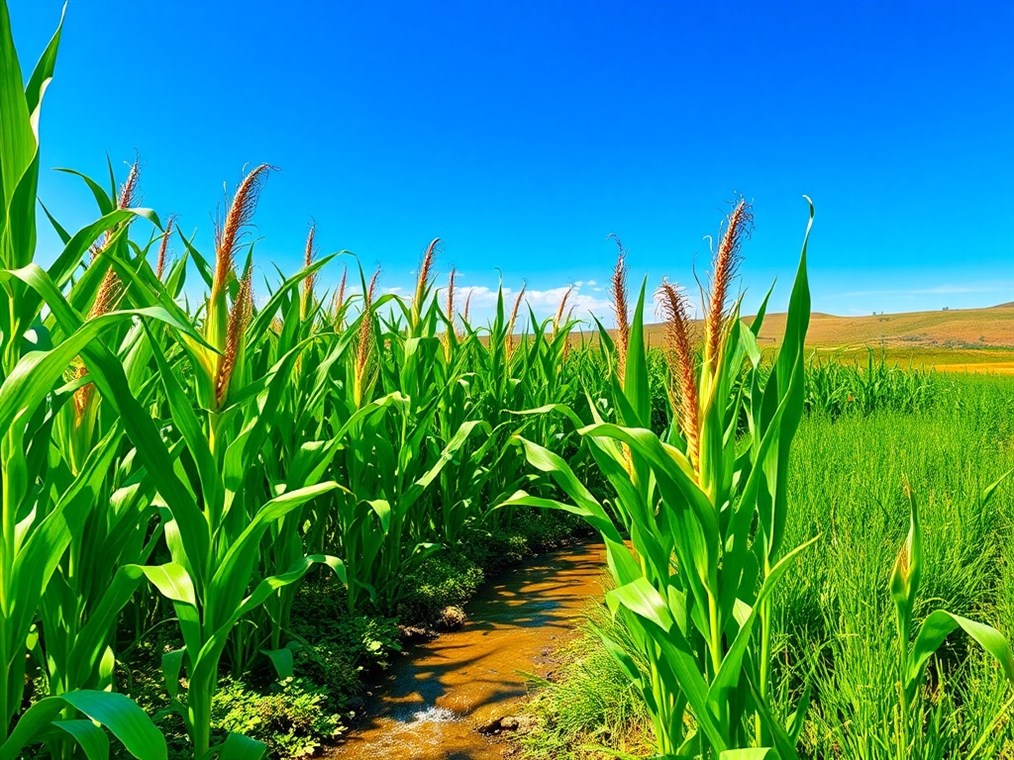How Much Water Does a Corn Plant Really Need? Let’s Talk Corn and Water.
Corn. It’s more than just a summer BBQ staple; it’s a global food source. But growing a bumper crop of corn takes more than just sunshine and good soil – it guzzles water. So, how much water are we talking about? Let’s dive in.
Generally speaking, a corn plant needs a good 22 to 30 inches of water throughout its growing season to really thrive. Think of it like this: that’s about 680,000 gallons per acre in the Midwest. Sounds like a lot, right? Well, it is! But keep in mind, that number isn’t set in stone. It’s more of a “it depends” situation. Things like when you planted, how close the plants are together, the specific type of corn you’re growing, where you’re located, and, of course, the weather, all play a role.
Here’s a fun fact: about 400,000 of those gallons are actually sucked up and used by the corn plants themselves. The rest? It evaporates from the soil. This whole process of water leaving the soil and the plant is called evapotranspiration, or ET for short. It’s a key factor when planning your irrigation strategy.
Now, when does corn need water the most? The answer is during its reproductive stages. Let’s break it down by growth stage:
- Baby Corn (Emergence to V6): When corn is just starting out, it doesn’t need a ton of water. Think of it like a newborn baby – small sips are enough. If you’ve had decent rain early on and the soil is holding moisture, you probably don’t need to irrigate right away. We’re talking about a daily water use of maybe 0.05 to 0.20 inches. A little drought at this stage isn’t the end of the world, as long as the rains come before it’s time to pollinate.
- Growing Up Fast (V6 to Tasseling): This is when things get serious. From the 8-leaf stage until the tassels pop out, the corn plant is growing like crazy, and its water needs skyrocket. The roots are digging deeper, and the plant is bulking up. Water use can jump to 0.32 inches per day, and even higher if it’s hot, dry, and windy. A drought during this phase (V8 to V14) can shrink the size of the ears and cut into your potential yield by 10% to 30%. Ouch!
- Making Babies (Tasseling to Dough): This is crunch time. Corn needs the most water right before and during reproduction. Imagine trying to run a marathon while dehydrated – that’s what water stress during silking is like for corn. It can mess up pollination big time, leading to major yield losses. You’re looking at water use rates around 0.30 to 0.35 inches per day until the dough stage. If drought hits during these reproductive stages, you could lose anywhere from 10% to a whopping 50% of your yield! Missing water during silk emergence and pollen shed can cost you 3% to 8% per day.
- Finishing Strong (Dough to Maturity): The finish line is in sight! Water use starts to taper off around the dough stage, dropping from 0.30 inches per day to about 0.20 inches by the time the kernels are fully dented. But don’t let your guard down. A severe drought can still knock 20% to 30% off your yield.
So, what else affects how much water your corn needs?
- Corn Type: Like people, some corn varieties are thirstier than others. Full-season corn usually needs more water than the early-maturing stuff.
- The Weather: Obvious, right? Sunny, hot, dry, and windy days crank up the water demand. Think of it like a clothes dryer on high heat.
- Your Soil: Soil is like a water reservoir. Sandy soils don’t hold water well, while clay soils are much better at it.
- Crowded Plants: The more plants you pack into an acre, the more water they’ll collectively use.
Okay, so how do you make sure your corn gets enough to drink? Here are a few tips:
- Know Your Soil: Get to know your soil and how well it retains moisture.
- Keep an Eye on Things: Regularly check soil moisture levels to know when to irrigate.
- Time it Right: Don’t let your corn get thirsty during tasseling, silking, and pollination.
- Be Efficient: Drip irrigation is your friend! It gets water right to the roots, minimizing waste.
- Strategic Thirst: In dry times, you can strategically cut back on water during less sensitive growth stages to conserve water for when it really matters.
What happens if your corn doesn’t get enough water?
Drought is bad news, plain and simple. It can delay silk emergence, reduce the number and weight of kernels, and even kill off plant tissue. Plus, stressed plants are more likely to get sick or attract pests.
Bottom line? Water is life for corn. By understanding its water needs and managing irrigation wisely, you can help ensure a healthy and productive harvest. And that’s something we can all raise a glass (of corn juice?) to!

